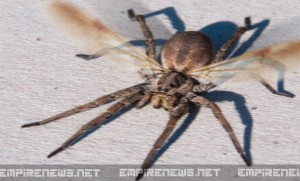TOCOA, Honduras, Central America –

What’s worse – a fear of spiders, or a fear of flying? How about about a fear of flying spiders?
If you suffer from a fear of either, perhaps you may want to read this story with caution. A research team analyzing a dying breed of insect accidentally discovered what they call The tinea volanti, or for us laymen, the flying spider.
“It was the scariest thing I’ve ever seen, but also the most fascinating,” said Prof. Althea Thoone, head researcher for The Smithsonian Institution’s Extinction Project. “We were in Honduras investigating the disappearance of Monarch butterflies,” explained Thoone, “when all of a sudden one of my researchers called me over to examine a spider variety she was unfamiliar with. I climbed over to where she was. We were on the side of a mountain. It was truly fascinating and amazing,” she explained.
The professor examined the spider and could not determine which variety of arachnid it was. As she went in for a closer look, what happened next sent shock waves buzzing through the insect community.
“It flew straight up and right into my face,” said Prof. Thoone. “It was startling and so fascinating! I was so shocked, I couldn’t speak. It took off like a hummingbird, with several of its legs vibrating at such a terrific speed, that it was nearly inaudible. Luckily, one of my colleagues was able to safely trap it in a net.”
The team also recovered a nearby nest of immature flying spiders that were preserved for future study. The ‘mother’ and ‘baby’ spiders are currently housed in a climate controlled insect lab in Washington. The full-grown arachnid measures in at almost 5 inches in length, not including the fore-stretched legs. It’s wingspan is an impressive 7 inches when fully opened for flight.
Several of Thoone’s colleagues, who have studied insects and bugs for most of their adult lives, were very happy with the discovery, even if several were a little disturbed by the idea of flying spiders.
“Of all the fears in the world, spiders are right up there for many people, even me, and I study creepy-crawlers for a living!” said Jennifer Charles, a colleague of Thoone’s. “I wasn’t in Honduras when they found the new species, but to be quite honest, when they brought them into the lab in Washington, I literally considered burning the entire building to the ground. They’re truly frightening, I tell you.”
The new tinea volante will be entered into a catalog designated for prospective new species. After a peer review, the spider – if it is of a unique and previously undiscovered variety – will be catalogued as a new entry into the exciting world of insects. Until then, Prof. Thoone is enjoying life in the limelight.
“All this attention – it’s fascinating! I’ve been researching insects and other threatened life forms for over 30 years, and you don’t expect this type of thing to happen. It’s like the holy grail of insect research. I made the cover of Bug & Beetle Quarterly, which is pretty big doin’s in our corner of the insect world! It was a 4-page spread. I’m overwhelmed!”
There’s talk about naming the new spider after Prof. Thoone. “They want to name it The Altheus Thoonicus,” said the professor, with tears in her eyes. “That would be so great, and so…fascinating,” she said.






























